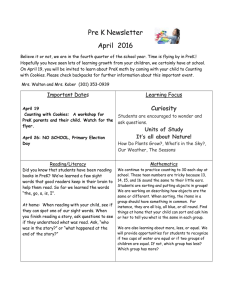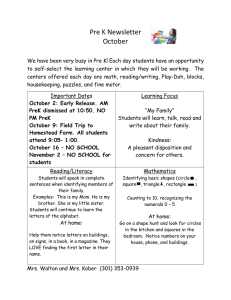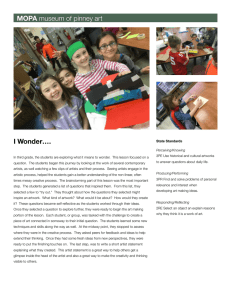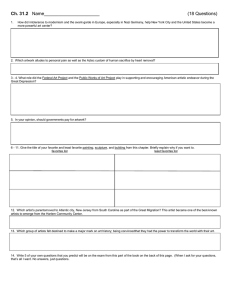California Visual Arts Content Standards
advertisement
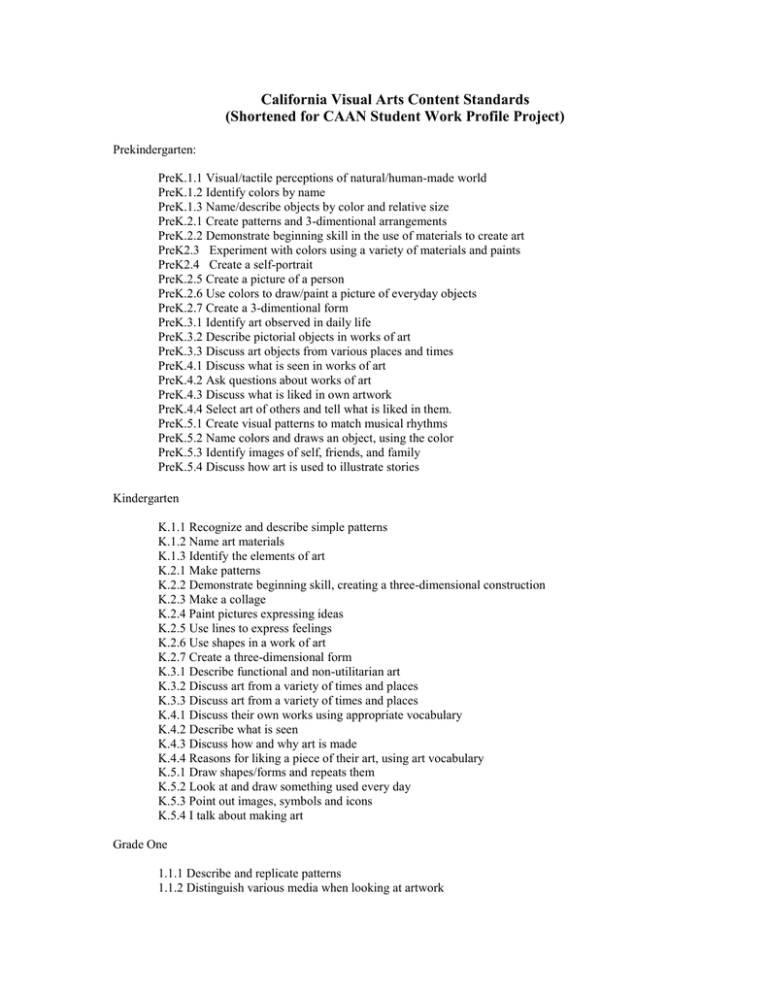
California Visual Arts Content Standards (Shortened for CAAN Student Work Profile Project) Prekindergarten: PreK.1.1 Visual/tactile perceptions of natural/human-made world PreK.1.2 Identify colors by name PreK.1.3 Name/describe objects by color and relative size PreK.2.1 Create patterns and 3-dimentional arrangements PreK.2.2 Demonstrate beginning skill in the use of materials to create art PreK2.3 Experiment with colors using a variety of materials and paints PreK2.4 Create a self-portrait PreK.2.5 Create a picture of a person PreK.2.6 Use colors to draw/paint a picture of everyday objects PreK.2.7 Create a 3-dimentional form PreK.3.1 Identify art observed in daily life PreK.3.2 Describe pictorial objects in works of art PreK.3.3 Discuss art objects from various places and times PreK.4.1 Discuss what is seen in works of art PreK.4.2 Ask questions about works of art PreK.4.3 Discuss what is liked in own artwork PreK.4.4 Select art of others and tell what is liked in them. PreK.5.1 Create visual patterns to match musical rhythms PreK.5.2 Name colors and draws an object, using the color PreK.5.3 Identify images of self, friends, and family PreK.5.4 Discuss how art is used to illustrate stories Kindergarten K.1.1 Recognize and describe simple patterns K.1.2 Name art materials K.1.3 Identify the elements of art K.2.1 Make patterns K.2.2 Demonstrate beginning skill, creating a three-dimensional construction K.2.3 Make a collage K.2.4 Paint pictures expressing ideas K.2.5 Use lines to express feelings K.2.6 Use shapes in a work of art K.2.7 Create a three-dimensional form K.3.1 Describe functional and non-utilitarian art K.3.2 Discuss art from a variety of times and places K.3.3 Discuss art from a variety of times and places K.4.1 Discuss their own works using appropriate vocabulary K.4.2 Describe what is seen K.4.3 Discuss how and why art is made K.4.4 Reasons for liking a piece of their art, using art vocabulary K.5.1 Draw shapes/forms and repeats them K.5.2 Look at and draw something used every day K.5.3 Point out images, symbols and icons K.5.4 I talk about making art Grade One 1.1.1 Describe and replicate patterns 1.1.2 Distinguish various media when looking at artwork 1.1.3 Identify the elements of art 1.2.1 Use texture in art 1.2.2 Mix secondary colors 1.2.3 Demonstrate skill in the use of materials 1.2.4 Communicate ideas or feelings in works of art 1.2.5 Create a representational sculpture 1.2.6 Draw or paint a still life 1.2.7 Use texture in art 1.2.8 Create artwork based on observations 1.3.1 Identify/discuss objects from various time periods and cultures 1.3.2 Identify/describe subject matter in art 1.3.3 View/describe art from various cultures 1.3.4 Compare/contrast art objects from various cultures 1.4.1 Discuss works of art created 1.4.2 Identify/describe reasons for making art 1.4.3 Describe how and why art is made 1.4.4 Critique personal art for positives and areas of change 1.5.1 Clap out rhythmic patterns found in visual arts 1.5.2 Compare and contrast objects of folk art 1.5.3 Identify/sort art objects into categories 1.5.4 Identify/describe objects designed by artists Grade Two 2.1.1 Perceive/describe repetition and balance 2.1.2 Perceive/discuss differences in mood color 2.1.3 Identify the elements of art in objects 2.2.1 Demonstrate skill in art-making processes 2.2.2 Demonstrate skill in the use of art media 2.2.3 Depict the illusion of depth in a work of using overlap/size/placement 2.2.4 Create using warm or cool colors expressively 2.2.5 Use symmetry to create balance 2.3.1 Explain how to share experiences/communicate ideas through art 2.3.2 Describe art objects from various cultures and time periods 2.3.3 Identify and discuss how art is used in cultures 2.4.1 Compare ideas expressed through art 2.4.2 Compare different responses to art 2.4.3 Use the vocabulary of art to talk to compare intent with product 2.4.4 Use appropriate vocabulary to discuss use of an element of art 2.5.1 Use placement/overlapping/size to show opposites 2.5.2 Use expressive colors to create mood and show personality 2.5.3 Identify and sort according to expressive qualities 2.5.4 Discuss artists in the community Grade Three 3.1.1 Perceive/describe rhythm and movement 3.1.2 Describe how artists use tints and shades 3.1.3 Identify/describe how to create the illusion of space 3.1.4 Compare/contrast two works of art 3.1.5 Identify/describe elements of art 3.2.1 Explore ideas in a sketchbook 3.2.2 Mix/apply tints, shades, and neutral colors 3.2.3 Paint or draw the illusion of space 3.2.4 Create a work of art based on daily life, emphasizing value changes 3.2.5 Create a sculpture based on an organic form 3.2.6 Create a printing process work emphasizing rhythm and movement 3.3.1 Compare and describe works with a similar theme, from different times 3.3.2 Identify artists and discuss art traditions 3.3.3 Distinguish and describe representational, abstract, and nonrepresentational 3.3.4 Identify and describe objects in a museum or gallery 3.3.5 Write about art from your cultural background 3.4.1 Compare and contrast works of art 3.4.2 Identify compositional/expressive qualities of art and what might be improved 3.4.3 Explain the successful compositional/communicative qualities of art 3.5.1 Describe how costumes contribute to dance meaning 3.5.2 Write a poem or story inspired by art 3.5.3 Look at and predict from images in art, support your ideas 3.5.4 Describe how artists have affected people’s lives Grade Four 4.1.1 Perceive/describe contrast and emphasis 4.1.2 Describe how negative and positive are used in art 4.1.3 Identify complementary colors used to communicate an idea or mood 4.1.4 Describe proportion as used in art 4.1.5 Describe and analyze the elements of art 4.2.1 Use shading (value) to transform shape into form 4.2.2 Use facial and figure proportions in study 4.2.3 Use additive and subtractive processes in sculpture 4.2.4 Create a simple weaving 4.2.5 Use accurate proportions in a figure drawing or painting 4.2.6 Use positive and negative space expressively 4.2.7 Use contrast expressively in original artwork 4.2.8 Use complementary colors to show contrast/emphasis 4.3.1 Describe the role art plays in reflecting life 4.3.2 Identify/discuss art in the past/present of California’s history and heritage 4.3.3 Research the influence of religious groups on buildings in California both past/present 4.4.1 Describe how the language of art helps in responding to art 4.4.2 Identify and describe how cultural context influences individual response 4.4.3 Discuss how subject and media effect art 4.4.4 Identify/describe how culture defines art 4.4.5 Describe how individual experiences influences art 4.5.1 Interpret/report on a nonobjective painting, through dance/movement 4.5.2 Research modern artists who used symmetry and then use bilateral/radial symmetry 4.5.3 Communicate ideas about an event through visuals 4.5.4 Read biographies and report how the artists mirrored/affected their time period/culture Grade Five 5.1.1 Identify/describe the principles of design 5.1.2 Identify/describe representational/abstract/nonrepresentational art 5.1.3 Compare/contrast art and the environment 5.2.1 Use one-point perspective to show space 5.2.2 Create observational drawings 5.2.3 Demonstrate beginning skill in manipulating digital imagery 5.2.4 Create an abstract composition 5.2.5 Assemble a found object sculpture to reflect unity and harmony as a theme 5.2.6 Use perspective in the creation of a real or imaginary scene 5.2.7 Communicate values, opinions, or insights through art 5.3.1 Describe how galleries and museums conserve art 5.3.2 Identify and describe various fine/traditional/folk arts from history 5.3.3 Identify/compare art from various regions of the United States 5.3.4 In selected artworks, observe changes in materials and styles over time 5.4.1 Identify how art principles affect personal responses to and evaluation of art 5.4.2 Compare different purposes from a culture for creating art 5.4.3 Develop/use criteria to assess works of art 5.4.4 Assess art, using specific criteria, and assess changes for improvement 5.5.1 Use perspective to depict geometric objects in space 5.5.2 Identify and design symbols for ideas/information 5.5.3 Research/report on artists and how their works play a role in our environment Grade Six 6.1.1 Identify and describe all the elements of art 6.1.2 Discuss theme, genre, style, idea, and differences in media 6.1.3 Describe how artists can show the same theme using different media/styles 6.1.4 Describe how balance is used effectively in art 6.2.1 Use observational drawing skills 6.2.2 Apply two-point perspective in a thematic work of art 6.2.3 Create using varying tints, shades, and intensities 6.2.4 Create art reflecting choice and increased technical skill 6.2.5 Express moods, feelings, themes, or ideas through media 6.2.6 Use technology to create original artwork 6.3.1 Research and discuss the role of the visual arts in history 6.3.2 Describe how cultural art has changed or not in theme/content over time 6.3.3 Compare/contrast images or designs from at least two selected cultures 6.4.1 Construct plausible interpretations of what they perceive in art 6.4.2 Identify and describe ways in which culture is reflected in art 6.4.3 Develop criteria to assess and critique works of art 6.4.4 Revise works of art after a critique, articulating reasons for their changes 6.5.1 Research art in theatrical productions in the past and in the present 6.5.2 Research characters found in a variety of cultures past and present 6.5.3 Create art metaphors to express the traditions and myths of selected cultures art 6.5.4 Describe advertising tactics and provide examples 6.5.5 Establish criteria in selecting art for exhibition Grade Seven 7.1.1 Describe art and life using the art elements/design principles 7.1.2 Identify and describe scale 7.1.3 Identify/describe the ways in which artists convey the illusion of space 7.1.4 Express how the art elements/design principles contribute to qualities of art works 7.2.1 Develop increasing skill in three different media 7.2.2 Show the illusion of depth on a two-dimensional surface 7.2.3 Use mixed media, guided by a selected principle of design 7.2.4 Develop skill in mixing and color relationships 7.2.5 Interpret reality and fantasy in art 7.2.6 Create art, using photography, computer graphics, or video 7.2.7 Create a series of art applying art elements/design skillfully 7.3.1 Research and describe how art reflects cultural values 7.3.2 Compare/contrast diverse art in how it reflects the society that made it 7.4.1 Compare a personal work of art to the work of a recognized artist 7.4.2 Analyze the relation of form and content of in art 7.4.3 Discuss the artistic value of specific works of art with others 7.4.4 Develop and apply criteria to assess and critique works of art 7.4.5 Identify what was reworked in a personal work; explain how it improved 7.5.1 Create a multimedia presentation of music/art to reflect the time/culture of an era 7.5.2 Depict lifestyles and scenes from selected civilizations 7.5.3 Examine how different representations of images lead to different interpretations 7.5.4 Identify professions and related skills in the visual arts Grade Eight 8.1.1 Describe the intent and content of works of art 8.1.2 Analyze/justify how choices contribute to the expressive quality of art 8.1.3 Analyze art elements/design principles in video/film/electronic media 8.2.1 Demonstrate increased technical skills in using art media 8.2.2 Design and create maquettes for sculpture 8.2.3 Create art, using photography, computer graphics, or video 8.2.4 Create an expressive figurative sculpture 8.2.5 Communicate a theme in a series of works 8.2.6 Create additive and subtractive sculptures 8.2.7 Design a work appropriate to and reflecting a public location 8.3.1 Examine art created to make a social comment or protest social conditions 8.3.2 Compare/contrast/analyze art from Western and non-Western cultures 8.3.3 Identify art created by women and the impact of those works on society 8.3.4 Discuss the contributions of immigrant culture on the art of a society 8.4.1 Investigate point of view on the interpretation of art from varied cultures 8.4.2 Investigate artist’s intent in a series; support opinions with reasoned statements 8.4.3 Interpret art through form and content 8.4.4 Develop and apply a set of criteria to assess and critique art 8.4.5 Debate value art work; respond to other arguments 8.4.6 Select a personal works of that reflect growth over time; describe the progression 8.5.1 Create a music video of a favorite artist; express personal ideas/views about the artist 8.5.2 Express personal opinions about current social or political issues through art 8.5.3 Demonstrate understanding of the effects of media on society 8.5.4 Work with a community artist; report on skills needed to be an artist Grades Nine Through Twelve – Proficient 9-12P.1.1 Discuss/analyze/write about the environment and art, in art terms 9-12P.1.2 Describe dominance and subordination in design 9-12P.1.3 Research/analyze effect of style and its contribution to meaning of work 9-12P.1.4 Analyze/describe how composition is affected by use of design principles 9-12P.1.5 Analyze/describe how material used influences meaning of work 9-12P.1.6 Compare/contrast art done in electronic media with traditional art 9-12P.2.1 Solve a problem involving art elements/design principles 9-12P.2.2 Prepare a portfolio that reflects refined craftsmanship/technical skills 9-12P.2.3 Develop and refine skill in digital imagery (still or video) 9-12P.2.4 Review and refine observational drawing skills 9-12P.2.5 Create expressive composition, focusing on dominance/subordination 9-12P.2.6 Create work of art that addresses a social issue 9-12P.3.1 Identify similarities/differences in intent of art in selected cultures 9-12P.3.2 Identify/describe the influence of technology on art 9-12P.3.3 Identify/describe trends in the arts, how time/place/culture are reflected in art 9-12P.3.4 Discuss the purposes of art in contemporary cultures 9-12P.4.1 Articulate how beliefs/traditions/contexts influence the interpretation of /message in art 9-12P.4.2 Compare how meaning is affected due to changes in interpretation/context 9-12P.4.3 Debate aesthetic value of an art work; consider views of others 9-12P.4.4 Articulate process/rationale for refining/reworking own artwork 9-12P.4.5 Employ the conventions of art criticism in practice 9-12P.5.1 Design an advertising campaign for a theatre/dance production 9-12P.5.2 Create a cross-cultural/universal theme taken from literature/history 9-12P.5.3 Compare and contrast the ways in which cover art exhibitions 9-12P.5.4 Demonstrate understanding of various artist career skills Grades Nine through Twelve – Advanced 9-12A.1.1 Analyze and discuss complex ideas in works of art. 9-12A.1.2 Discuss a series of original artworks, using art vocabulary 9-12A.1.3 Analyze personal works for direction and style 9-12A.1.4 Research two periods and discuss their similarities and differences, using arts language 9-12A.1.5 Compare how distortion is used in photography/video vs. painting/sculpture 9-12A.1.6 Describe use of art elements to express mood in own artworks 9-12A.1.7 Critique three personal works for the intent and use of the media 9-12A.1.8 Analyze art media and the effect of selection on an artist’s style 9-12A.2.1 Create art of increasing complexity/skill to reflect feelings/points of view 9-12A.2.2 Plan and create works of art that reflect complex ideas 9-12A.2.3 Assemble/display objects or works of art as part of a public exhibition 9-12A.2.4 Demonstrate personal art of an advanced proficiency communicating idea/theme/emotion 9-12A.2.5 Use innovative metaphors in creating works of art 9-12A.2.6 Demonstrate technology skills. In a universal concept multimedia work 9-12A.3.1 Identify/discuss contemporary art social/economic/political developments 9-12A.3.2 Identify/discuss artists’ work that reflects/plays a role in/influences present-day culture 9-12A.3.3 Investigate/discuss universal concepts expressed in diverse artwork 9-12A.3.4 Research the methods art historians use on a given work of art 9-12A.4.1 Describe relationship involving artist, process, product, and viewer 9-12A.4.2 Identify/explore implications of artists’ intentions creating contemporary art works 9-12A.4.3 Analyze/discuss how society influences interpretation/message of art work 9-12A.4.4 Apply theoretical perspectives to personal works of art and the work of others 9-12A.4.5 Construct rationale for specific artwork validity that falls outside own conceptions 9-12A.4.6 Develop criteria for selection of artwork from own portfolio that has significance 9-12A.5.1 Speculate how technology might change the definition/function of the arts 9-12A.5.2 Compare/contrast art works for psychological content found in symbols/images 9-12A.5.3 Prepare portfolios for a variety of purposes 9-12A.5.4 Investigate/report essential features of modern/emerging technologies

